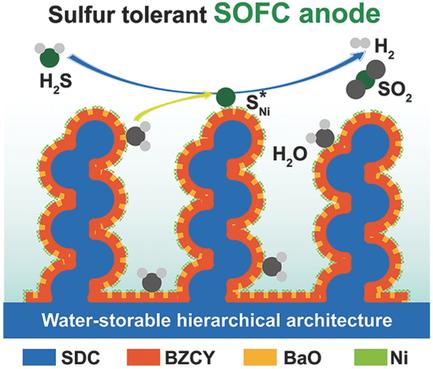Our official English website, www.x-mol.net, welcomes your feedback! (Note: you will need to create a separate account there.)
Rational Design of a Water‐Storable Hierarchical Architecture Decorated with Amorphous Barium Oxide and Nickel Nanoparticles as a Solid Oxide Fuel Cell Anode with Excellent Sulfur Tolerance
Advanced Science ( IF 15.1 ) Pub Date : 2017-09-15 , DOI: 10.1002/advs.201700337 Yufei Song 1 , Wei Wang 2 , Lei Ge 3 , Xiaomin Xu 2 , Zhenbao Zhang 1 , Paulo Sérgio Barros Julião 2 , Wei Zhou 1 , Zongping Shao 2, 4
Advanced Science ( IF 15.1 ) Pub Date : 2017-09-15 , DOI: 10.1002/advs.201700337 Yufei Song 1 , Wei Wang 2 , Lei Ge 3 , Xiaomin Xu 2 , Zhenbao Zhang 1 , Paulo Sérgio Barros Julião 2 , Wei Zhou 1 , Zongping Shao 2, 4
Affiliation

|
Solid oxide fuel cells (SOFCs), which can directly convert chemical energy stored in fuels into electric power, represent a useful technology for a more sustainable future. They are particularly attractive given that they can be easily integrated into the currently available fossil fuel infrastructure to realize an ideal clean energy system. However, the widespread use of the SOFC technology is hindered by sulfur poisoning at the anode caused by the sulfur impurities in fossil fuels. Therefore, improving the sulfur tolerance of the anode is critical for developing SOFCs for use with fossil fuels. Herein, a novel, highly active, sulfur‐tolerant anode for intermediate‐temperature SOFCs is prepared via a facile impregnation and limited reaction protocol. During synthesis, Ni nanoparticles, water‐storable BaZr0.4Ce0.4Y0.2O3−δ (BZCY) perovskite, and amorphous BaO are formed in situ and deposited on the surface of a Sm0.2Ce0.8O1.9 (SDC) scaffold. More specifically, a porous SDC scaffold is impregnated with a well‐designed proton‐conducting perovskite oxide liquid precursor with the nominal composition of Ba(Zr0.4Ce0.4Y0.2)0.8Ni0.2O3−δ (BZCYN), calcined and reduced in hydrogen. The as‐synthesized hierarchical architecture exhibits high H2 electro‐oxidation activity, excellent operational stability, superior sulfur tolerance, and good thermal cyclability. This work demonstrates the potential of combining nanocatalysts and water‐storable materials in advanced electrocatalysts for SOFCs.
中文翻译:

合理设计非晶态氧化钡和镍纳米粒子装饰的储水分层结构作为具有优异耐硫性的固体氧化物燃料电池阳极
固体氧化物燃料电池(SOFC)可以直接将燃料中储存的化学能转化为电能,是一种可实现更可持续未来的有用技术。它们特别有吸引力,因为它们可以很容易地集成到当前可用的化石燃料基础设施中,以实现理想的清洁能源系统。然而,SOFC技术的广泛使用受到化石燃料中硫杂质引起的阳极硫中毒的阻碍。因此,提高阳极的耐硫性对于开发用于化石燃料的 SOFC 至关重要。在此,通过简单的浸渍和有限的反应方案制备了一种用于中温 SOFC 的新型高活性耐硫阳极。在合成过程中,Ni纳米颗粒、耐水BaZr 0.4 Ce 0.4 Y 0.2 O 3− δ (BZCY)钙钛矿和无定形BaO原位形成并沉积在Sm 0.2 Ce 0.8 O 1.9 (SDC)支架的表面上。更具体地说,将多孔SDC支架浸入精心设计的质子传导钙钛矿氧化物液体前体中,其标称成分为Ba(Zr 0.4 Ce 0.4 Y 0.2 ) 0.8 Ni 0.2 O 3− δ (BZCYN),在氢。合成的分级结构表现出高H 2电氧化活性、优异的操作稳定性、优异的耐硫性和良好的热循环性。这项工作展示了将纳米催化剂和储水材料结合在先进的 SOFC 电催化剂中的潜力。
更新日期:2017-09-15
中文翻译:

合理设计非晶态氧化钡和镍纳米粒子装饰的储水分层结构作为具有优异耐硫性的固体氧化物燃料电池阳极
固体氧化物燃料电池(SOFC)可以直接将燃料中储存的化学能转化为电能,是一种可实现更可持续未来的有用技术。它们特别有吸引力,因为它们可以很容易地集成到当前可用的化石燃料基础设施中,以实现理想的清洁能源系统。然而,SOFC技术的广泛使用受到化石燃料中硫杂质引起的阳极硫中毒的阻碍。因此,提高阳极的耐硫性对于开发用于化石燃料的 SOFC 至关重要。在此,通过简单的浸渍和有限的反应方案制备了一种用于中温 SOFC 的新型高活性耐硫阳极。在合成过程中,Ni纳米颗粒、耐水BaZr 0.4 Ce 0.4 Y 0.2 O 3− δ (BZCY)钙钛矿和无定形BaO原位形成并沉积在Sm 0.2 Ce 0.8 O 1.9 (SDC)支架的表面上。更具体地说,将多孔SDC支架浸入精心设计的质子传导钙钛矿氧化物液体前体中,其标称成分为Ba(Zr 0.4 Ce 0.4 Y 0.2 ) 0.8 Ni 0.2 O 3− δ (BZCYN),在氢。合成的分级结构表现出高H 2电氧化活性、优异的操作稳定性、优异的耐硫性和良好的热循环性。这项工作展示了将纳米催化剂和储水材料结合在先进的 SOFC 电催化剂中的潜力。




























 京公网安备 11010802027423号
京公网安备 11010802027423号